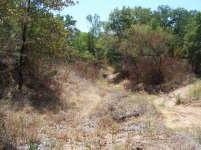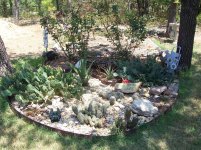Noticed while out walking the fence the neighbor lost a huge oak tree, I have gave him some fire wood and he has cut a little, but he is like me in the sense we hate to cut a good tree. I guess he should get most of what he needs out of that big one. I have lost about 10 oaks, a few Live Oaks and all the 60 trees I planted last year.
Dennis,
Sorry to hear about your trees. Planting oaks is an investment for future generations and the climate that we can only hope will be used wisley. Sad to say around here you often see truckloads of 12-18" diameter 40' oak logs
on the way to sawmills that cut them up for shipping pallets. I guess that is one of the factors that makes a red oak project board at Lowes $6 a board foot nowadays. Attached is a picture of an old oak on a field line of mine. I took the picture in 2006. It is actually a vertical sew/pan of 6 exposures from standing near the bottom of the tree. It has been estimated to be close to 150 years old. I don't know if TBN will allow it to load this size but if they do, download it and view it full size on your monitor to get the massiveness.
Looks like they accepted it at 972kb. I think they have a 1MB limit.
Ron



